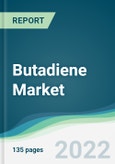Butadiene is a colorless gas considered to be an industrial chemical precursor to synthetic rubber production, among other activities. This includes styrene-butadiene rubber (SBR), utilized in the tire compound rubber, and nitrile butadiene rubber (NBR), an oil and fuels resistant rubber. Polybutadiene rubber is also greatly used, especially in the manufacturing of adhesives and sealants as well as in modification of asphalt. Further, butadiene is reactive and has unique physical properties which are used in several industries.
The butadiene market has witnessed growth primarily due to the growing consumption of synthetic rubber in the automobile, construction, and consumer goods industries, where butadiene plays an important role.
There has also been positive growth in the butadiene demand globally owing to the rising infrastructure investments. The overall investment by the UK government into the infrastructure sector as of 2023 was around £13.8 billion, a rise of around 3.9% from the previous year. Likewise, demand for infrastructure sector assets also rose, with net assets of the infrastructure sector being valued at £350.2 billion, an increase of 0.3% from 2022.
Demand for infrastructure sector assets also rose, with net assets of the infrastructure sector being valued. Further, the investment by companies in procurements in butadiene facilities will, in turn, accelerate the market growth more so that advanced technology is employed to increase productivity and reduce expenditures and waste emissions. For instance, a new styrene-butadiene copolymer (SBC) project was launched by a subsidiary of China Petroleum & Chemical Corporation Sinopec in Hainan, China, with an annual capacity of 170,000 tons, which started in April 2023.
Butadiene market drivers
Expanding Automotive Sector
Butadiene is one of the important materials for the automotive industry, which is mainly due to the production of synthetic rubber used in vehicles. The optimistic projections related to this market include the production of tires, the leading consumer of butadiene, and the manufacturing of automotive components with butadiene-based products for hoses, belts, and seals. With the increasing market for automotive products, the consumption of tires will witness a drastic increase, propelling the butadiene market. In the Annual data report by OICA, the Motor Vehicle Manufacturers Global Association elaborated on vehicle production in 2023 exceeded the volumes noted where 84.830 million units were produced in 2022, rising to 93.546 million units in 2023. Further, in 2023, the production of vehicles in China was 30.130 million vehicles and 10.611 million in the USA. Such a growing vehicle population across the globe will potentially contribute to the market growth in the subsequent yearsButadiene market Geographical outlooks
The United States in the North American region is expected to hold significant shares of theButadiene market.Themarket in the United States is mainly influenced by the demand for butadiene as a base product for producing and processing elastomers and their chemical derivatives. Such elastomers include Acrylonitrile Butadiene Styrene, Poly Butadiene Rubber, and Styrene Butadiene Rubber (SBR), amongst others. Nevertheless, due to its inherently high resistance to slip and wear and its ability to withstand various organic solvents, oils, and fuels, SBR is in great demand across all sectors. Polystyrene-Polybutadiene rubber, a very popular synthetic rubber, is found in most of the applications in tires and other industrial products.
Moreover, the rising demand for this specific rubber from the tire segment is among the key factors contributing to the growth. Moreover, demand for butadiene will increase, particularly in the forecast period, because of the production of advanced materials like butadiene acrylonitrile for automotive applications and increased export of butadiene rubber. For instance, butadiene rubber was exported by the United States to Mexico at $91,995.92K for 53,441,000 Kg and Canada at $68,221.64k for 34,471,500 Kg as per data from WTIS.
Reasons for buying this report:
- Insightful Analysis: Gain detailed market insights covering major as well as emerging geographical regions, focusing on customer segments, government policies and socio-economic factors, consumer preferences, industry verticals, other sub-segments.
- Competitive Landscape: Understand the strategic maneuvers employed by key players globally to understand possible market penetration with the correct strategy.
- Market Drivers & Future Trends: Explore the dynamic factors and pivotal market trends and how they will shape up future market developments.
- Actionable Recommendations: Utilize the insights to exercise strategic decision to uncover new business streams and revenues in a dynamic environment.
- Caters to a Wide Audience: Beneficial and cost-effective for startups, research institutions, consultants, SMEs, and large enterprises.
What do businesses use our reports for?
Industry and Market Insights, Opportunity Assessment, Product Demand Forecasting, Market Entry Strategy, Geographical Expansion, Capital Investment Decisions, Regulatory Framework & Implications, New Product Development, Competitive IntelligenceReport Coverage:
- Historical data & forecasts from 2022 to 2030
- Growth Opportunities, Challenges, Supply Chain Outlook, Regulatory Framework, Customer Behaviour, and Trend Analysis
- Competitive Positioning, Strategies, and Market Share Analysis
- Revenue Growth and Forecast Assessment of segments and regions including countries
- Company Profiling (Strategies, Products, Financial Information, and Key Developments among others)
The Butadiene market is segmented and analyzed as below:
By Application
- Styrene-Butadiene Rubber (SBR)
- Polybutadiene
- Nitrile Rubber
- Styrene Butadiene Latex
- Acrylonitrile Butadiene Styrene (ABS)
- Adiponitrile
- Polychloroprene
- Others
By Geography
- North America
- South America
- Europe
- Middle East and Africa
- Asia-Pacific
Table of Contents
Companies Mentioned
- LOTTE Chemical Corporation
- JSR Corporation
- Sinopec
- ENEOS Holding Inc.
- Zeon Corporation
- Exxon Mobil Corporation
- BASF SE
- Shell Plc
- LyondellBasell Industries Holdings B.V.
- Reliance Industries Ltd.
- TPC Group
- CNPC (China National Petroleum Corporation)
- Borealis AG
Table Information
| Report Attribute | Details |
|---|---|
| No. of Pages | 135 |
| Published | December 2024 |
| Forecast Period | 2025 - 2030 |
| Estimated Market Value ( USD | $ 15.04 Billion |
| Forecasted Market Value ( USD | $ 20.23 Billion |
| Compound Annual Growth Rate | 6.1% |
| Regions Covered | Global |
| No. of Companies Mentioned | 13 |









